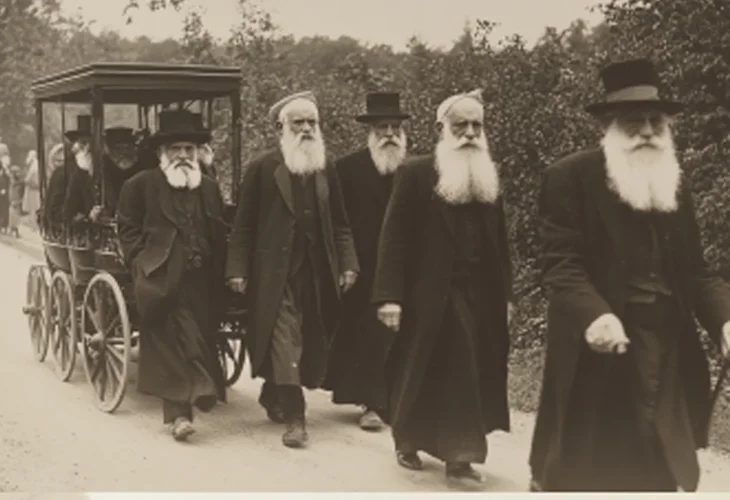Bridging Hearts: The Encounter That Sparked Jewish Spirit in Settlements and Kibbutzim
A peculiar procession was seen through the farm gates: ten elderly Jewish men, some very old and with white beards, dressed in traditional Jerusalem attire, arriving in three carriages to the colony and the farm. What are such people doing in the heart of the working settlement?

It was in the month of Kislev. The first rains had already fallen, and the entire area south of the Kinneret was covered in fresh green carpet. At the farm near the Kinneret settlement, young women gathered for practical training in soil work, digging irrigation ditches and fertilizing seedlings. The instructor, agronomist Dr. Hannah Meisel, tried to capture the attention of her trainees, who were focused on a peculiar procession seen through the farm gates: ten elderly Jewish men, some with white beards, dressed in traditional Jerusalem attire, arriving in three carriages to the settlement and the farm. What are such people doing in the heart of the working settlement?
The year was 1914. Kinneret was considered one of the notable colonies of the Workers' Union, a showcase of the Zionist Organization's Israeli department. They were accustomed to visits from Arthur Ruppin or Berl Katzenelson, but not from rabbis. "We have no shortage of our own intellectuals," said Hannah Meisel. "Look, Rachel Bluwstein writes poetry as beautifully as their Bible," she added.
The delegation of rabbis was a special project initiated by Jerusalem's rabbis, led by Rabbi Abraham Isaac HaCohen Kook, the chief rabbi of Jaffa and the colonies, and Rabbi Yosef Chaim Sonnenfeld, head of the Orthodox Jewish community in Jerusalem. The collaboration between these two figures was not a given. They had sharp disagreements, but for the noble goal of uniting hearts, they joined forces, along with other famous rabbis, like Rabbi Ben Zion Yadler, Rabbi Yaakov Moshe Charlap, and more, setting out on a "colony tour," spreading Judaism and Torah among the new settlements in the Land of Israel.
In secular socialist settlements like the Kinneret farm and similar places, established by immigrants of the Second Aliyah who were mostly communists and distant from spirituality, the rabbis did not achieve great success. However, even in these areas, there were Jews who listened intently. At the Kinneret farm, there were several families of Yemenite workers who had not seen a Jewish rabbi for a long time, and they eagerly absorbed the strengthening words of the rabbis.
But in colonies established by First Aliyah immigrants, such as Hadera, Zikhron Ya'akov, Rosh Pina, and more, and in older cities like Tiberias and Safed, the rabbis found an attentive audience. Everywhere they went, the rabbis inquired about the kosher status, whether there was a mikveh, synagogues, or an eruv in the area. They listened, gave instructions, explained, and promised to provide support and answers to all questions on Jewish matters.
In colonies where there was no synagogue, the rabbis gathered the residents and organized a fundraiser to establish one, and foundation stones for future synagogues were laid. Sometimes, after hours of Torah talks and encouragement, the audience and guests would break into a spirited Jewish dance. Despite the widespread desolation in the colonies, the rabbis saw potential and an attentive audience, and Rabbi Kook said, "We arrived a bit late, but not too late."
Rabbi Yonatan Benjamin Halevy Horowitz, a participant in the journey, recorded his impressions in his book "These are My Journeys." According to him, in most places, the rabbis were received with great respect, and their words and actions had a significant impact.
Later that year, a few months after the visit, World War I broke out, which was a major blow to the colonies. The Turks harassed and mistreated the Jews, expelled some from their homes, and deprived them of food. Many troubles plagued the settlement, and naturally, when times are hard, there is little energy to invest in spirituality, synagogues, mikvehs, or kosher practices.
After the war, the Jerusalem rabbis, led by Rabbi Kook, repeatedly went back to the colonies to see what could be strengthened again. However, the communist-secular atmosphere in the colonies and kibbutzim also became very strong. In the third journey, Rabbi Kook traveled with Rabbi Meir Berlin, son of the Netziv of Volozhin, and other rabbis to the heart of the Zionist settlements disconnected from Jewish spark: Tel Adashim, Balfouria, Kfar Yehezkel, Nahalal, Ein Harod, Merhavia, Kibbutz Kinneret, and Degania. In one place, a member of the kibbutz approached them during the reception and said, "Your time, work, and words are wasted here; you won't influence anything." Rabbi Kook, with humility and insight, replied, "We don't need to influence now; we want to be influenced by your dedication to the holy land." And indeed, if words don't bear fruit in the present, they may do so in the future. Today, in many of the most secular and disconnected colonies and kibbutzim, one can find synagogues, mikvehs, and kosher food, thanks to many more journeys of rabbis, spiritual figures, and good Jews to the spiritual wilderness, enriching it with Torah words, and thanks to the Jewish spark found wherever there are descendants of Abraham, Isaac, and Jacob.

